3 April 2003
Iles des Saintes, Guadeloupe N 15.5209 W61.3642
Montserrat, Guadeloupe and the anchor dance
With everything at the ready we must wait now until the weather improves. You shouldn't think that we are encounteri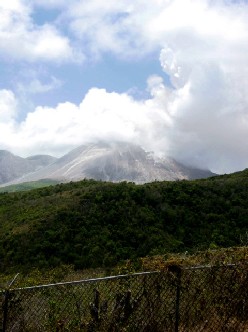 ng bad weather since each day the temperature is in the eighties and the humidity in the sixties with a nice breeze and an occasionally rain shower. But a high is moving in which will increase the seascape and winds and swells will follow which could make the journey and the anchorage at our destination uncomfortable. So we sit ready to move, finding ways to entertain ourselves. ng bad weather since each day the temperature is in the eighties and the humidity in the sixties with a nice breeze and an occasionally rain shower. But a high is moving in which will increase the seascape and winds and swells will follow which could make the journey and the anchorage at our destination uncomfortable. So we sit ready to move, finding ways to entertain ourselves.
Several days ago we traveled to Montserrat to get a closer look at the volcano which may sound counter intuitive but proved to be fascinating. The world's only active volcano made itself known in 1995 when it erupted and destroyed the major population centers and forced the people of Montserrat to flee the island or relocate to the northern side where little if any infrastructure existed. The volcano then went dormant in 1997 but for less than a year. Today it is still a threat to the island and for that matter the whole of the Caribbean.
We took the ferry over with a small group of new acquaintances and there we met our tour guide, Thomas, who took us to observation points, the MVO (Montserrat Volcano Observatory), the island's cultural center and to lunch. The video we saw of the island before the eruption in 1995 depicted the beauty of the "Emerald Island" so named because of the many Irish immigrants who helped settle Montserrat. The eruption has created a moonscape mountain that has grown by 700 feet and buried the towns that housed the cruise liner docks and the attendant restaurants, hotels, golf course and gift shops. Now the island is divided into two sections with the northern part still inhabitable and the southern "exclusion zone". Luxury h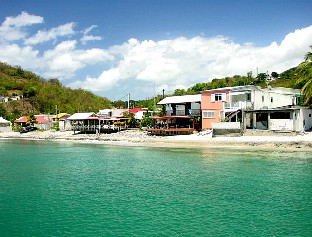 ouses sit abandoned in this area along with a recording studio where many well known artists ( Elton John, Paul McCartney, Eric Clapton, Sting, and many more recognizable names), recorded while enjoying this once tropical paradise. Trespassers into the exclusion zone are fined $2,000 and sentenced to six months in jail. As Thomas, our guide, pointed out the only inhabitants in the houses are "da bees an da bugs". ouses sit abandoned in this area along with a recording studio where many well known artists ( Elton John, Paul McCartney, Eric Clapton, Sting, and many more recognizable names), recorded while enjoying this once tropical paradise. Trespassers into the exclusion zone are fined $2,000 and sentenced to six months in jail. As Thomas, our guide, pointed out the only inhabitants in the houses are "da bees an da bugs".
From the observation locations we were able to see boulders as large as a house tumble down the side of the volcano leaving a plume of dust behind. We are told at night the boulders glow red encouraging our tour operator to offer night trips in the future. Occasionally steam clouds fill the sky with dust and dirt and this activity has been known to close airports as far away as Puerto Rico. The international team of volcanologists watch the volcano grow by GPS and closely monitor the seismographic information and gas emissions in an attempt to foretell any future cataclysmic activity.
As we continue to wait we are making the rounds of cocktail parties, beach pot luck lunches and book exchanges with a group of cruisers also waiting for the weather.
We have met a delightful group of people and will stay in touch as we continue our journey since many are headed in the same direction.
After this side excursion we were finally able to set sail for the French island of Guadeloupe and the port of Deshaies (pronounced Day-hay) on the northern tip. This small harbor with its deep anchorage provides an enhancement of the typical cruiser entertainment which is watching other people anchor. Boats enter a harbor and poke around until they find a location that is within the amount of scope they carry, provides a good bottom for the type of anchor and will leave them enough swing room so as not to interfere with surrounding boats. As the anchorages get deeper, and we are told they will from this point south, this activit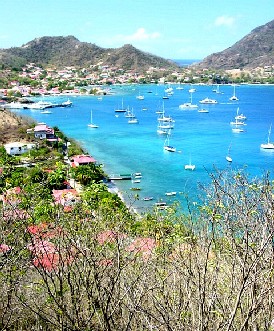 y becomes more difficult and once your anchor is down and set it becomes more entertaining to watch others. Experienced couples have hand signals that assist in communication and people that charter yell or curse at one another loud enough to be heard over the din of the engines and all in accordance to the amount of excitement. Now with the anchor down it's a matter of letting it settle and dig into the sand or mud and then backing down on the anchor with the engines to ensure the set. Next you attach a bridle to the anchor chain in order to add some elasticity to the contraption and finally you put on your snorkeling gear and swim out to see how it looks. If you don't like the looks of it you pull it up and start all over again. In Deshaies one friendly fellow whom we all called Buddha came to the bow of his boat in his underwear with his swollen brown stomach flopped over the bow spirit. With his arms akimbo and an occasional scratch he attempted to intimidate entering boats from anchoring close to his. In one case he actually went out in his dinghy, still san underwear, to tell Indigo a US flagged vessel to leave and when that didn't work took a picture of the transom to capture the name and hailing port supposedly for insurance purposes if something should occur. He was doing such a good job that every boat that came in found the most space near his boat and the dance began all over again.. We had a ring side seat since he didn't chase us off and we were right next door. y becomes more difficult and once your anchor is down and set it becomes more entertaining to watch others. Experienced couples have hand signals that assist in communication and people that charter yell or curse at one another loud enough to be heard over the din of the engines and all in accordance to the amount of excitement. Now with the anchor down it's a matter of letting it settle and dig into the sand or mud and then backing down on the anchor with the engines to ensure the set. Next you attach a bridle to the anchor chain in order to add some elasticity to the contraption and finally you put on your snorkeling gear and swim out to see how it looks. If you don't like the looks of it you pull it up and start all over again. In Deshaies one friendly fellow whom we all called Buddha came to the bow of his boat in his underwear with his swollen brown stomach flopped over the bow spirit. With his arms akimbo and an occasional scratch he attempted to intimidate entering boats from anchoring close to his. In one case he actually went out in his dinghy, still san underwear, to tell Indigo a US flagged vessel to leave and when that didn't work took a picture of the transom to capture the name and hailing port supposedly for insurance purposes if something should occur. He was doing such a good job that every boat that came in found the most space near his boat and the dance began all over again.. We had a ring side seat since he didn't chase us off and we were right next door.
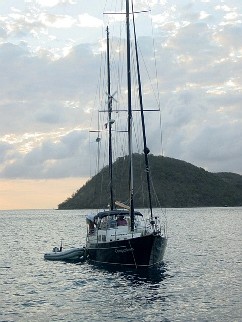
After two days and a bus ride to Pointe 'a Pitre to sign in to customs and immigration, we moved to Iles des Saintes (The Saints) a group of small islands on the southern end of Guadeloupe with our traveling companion Camperdown. The O'Neil's are Purdue graduates. Alan grew up in Indianapolis and after Purdue practiced Veterinarian Medicine in the Chicago area. Cindy founded an architectural firm headquarted in Chicago. They are on their third year of cruising and have been very helpful with advice and a delight to travel with. Anchoring at The Saints provided a new challenge since in hauling up about 190 feet of chain in Deshaies, the fuse blew on our windless so we had no power to lower the anchor in The Saints. After hand lowering 100 feet, we became entangled in a mooring ball and had to pull up all this 3/8 inch chain with a 45 pound CQR anchor by hand. A helpful Swiss couple advised us of our entanglement and were very helpful. Finally, with the anchor free and up, we found another anchor spot and lowered the anchor, replaced the fuse and are off to explore the Saints.
We continue to listen to the war news on the BBC and NPR. With little news on the 4th ID it becomes a bit frustrating. As of this writing Josh has not yet deployed but the equipment is about to be shipped.
22 April 2003
Isles des Saintes, Dominica and Martinique
Making South on the Leeward (Loow'rd) side
The Saintes provide an interesting contrast to the rest of Guadeloupe.
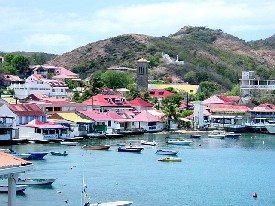 These small islands are located south of the main island and at one time acted as important military encampments for the French. Located on one of the highest hills surrounding the bay is the reconstructed Fort Napoleon, originally built in 1867. The fort houses room after room dedicated to military history which recounts how the French Navy was defeated by the British under Admiral Rodney in 1782. There are also rooms dedicated to local history and the fishing industry. Even in defeat the French find victory by charging a small admission fee. Living amongst the prickly pears, cacti and surrounding shrubby near the fort is a plethora of iguana, some up to five feet in length. These small islands are located south of the main island and at one time acted as important military encampments for the French. Located on one of the highest hills surrounding the bay is the reconstructed Fort Napoleon, originally built in 1867. The fort houses room after room dedicated to military history which recounts how the French Navy was defeated by the British under Admiral Rodney in 1782. There are also rooms dedicated to local history and the fishing industry. Even in defeat the French find victory by charging a small admission fee. Living amongst the prickly pears, cacti and surrounding shrubby near the fort is a plethora of iguana, some up to five feet in length.
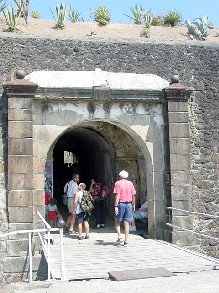
We had the opportunity to celebrate Rene's birthday with a fine French meal while at The Saintes. The island's principle industry was fishing until tourism became more attractive. So now ferries fill the one large dock and cruising boats that can anchor in the deep water search for a place to bring their dinghy's ashore. It reminds me of another small group of islands in Lake Erie where the residents of South Bass Island refer to the day tourist that come in on the ferry as "dock trash" and those that anchor out or dock their boats as "boat trash". Of course these two groups make up the only source of income for the residents of Put-in-Bay. Anyway it's nice to now have moved up to "boat trash" .
Internet access was a bit of a task in The Saintes Typically we find access at a French location with a start page that is in French and all directions in French (not difficult to understand) but at this one location the keyboard was of a French configuration and not the QWERTY configuration we are use to. This of course extended the amount of time since it was all hunt and peck for each letter.
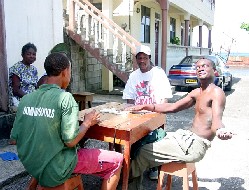
Now it's on to Dominica where we checked in and out at Prince Rupert Bay on the northern shore with a 72 hour permit . In this small city the native language is a version of Creole although everyone also speaks English. We arrived in Dominica on Good Friday and the town was all but closed down for revival meetings for the believers and dominos for the unconverted. The population is very friendly and we encountered our first boat boys before we even anchored. These entrepreneurs race out to your boat as you are coming into port with the offer to be of assistance while you visit or to be your guide for a tour of the river. We signed up with Jeffery on Sea Bird, a certified guide and member of the guide association. The Indian River tour 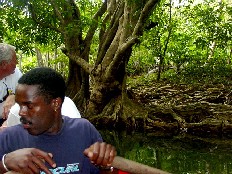 started at 7 AM and since no motors are allowed on the river, the trip is made by Jeffery rowing a mile plus up the river and then it's a hike through the rain forest. Jeffery proved to be a friendly and professional guide and we would highly recommend him to any boats coming into Dominica. Be sure that you ask to see the badge showing they are certified guides. There are those that claim to be, but aren't. started at 7 AM and since no motors are allowed on the river, the trip is made by Jeffery rowing a mile plus up the river and then it's a hike through the rain forest. Jeffery proved to be a friendly and professional guide and we would highly recommend him to any boats coming into Dominica. Be sure that you ask to see the badge showing they are certified guides. There are those that claim to be, but aren't.
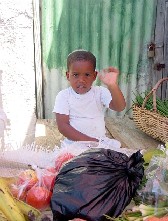
Every island that we have visited has open air markets on Friday and Saturday and oh did I mention medical schools for U.S. students? Dominica proved to be no different. So before heading to Martinique we went to the market for fresh vegetables and to the service station for diesel and gasoline. This is no fun task as most of the time we have to fill four 5 gallon cans with diesel and take them back to our boat and many times more than one trip is necessary. On our last evening in Dominica, Jeffery, our guide, brought us fresh tuna which we grilled with our friends Alan and Cindy. We left Dominica on Easter Sunday en route to Martinique and more French baguettes. Enroute we heard a response to a Mayday call. A red catamaran was upside down about five miles south of Dominica and a large cruise ship at the dock in Roseau had intercepted the call. The cruise ship tenaciously stayed on the channel until both the Dominica and Martinique Coast Guard responded. The three adults and one child onboard were rescued by a passing mega-yacht. We have not found out why the boat "turtled" but the boat was now a navigation hazard that we watched carefully for the next day.
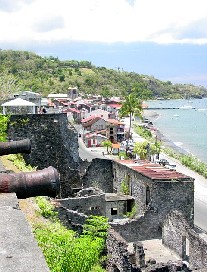
Martinique is the largest of the Windward Islands and our first stop was at the bay of St. Pierre. As we tied the dinghy to the dock on Easter Monday we encountered a group of young men with dreadlocks celebrating this religious holiday by lighting up a joint or two. They were rolling the largest dubie I've seen since the days of Cheech and Chong movies. We surprised them as we walked from the ocean side of the dock but not enough to make anyone nervous enough to move. Speaking of lighting up, St. Pierre lies at the foot of Mt. Pelee's volcano which erupted on May 8, 1902. The volcano gave many warnings that an eruption was inevitable but Governor Mouttet, who had been governor of Martinique for less than a year, wanted desperately for the problem to just go away (so typically French). He was encouraged by the local plantation owners and business leaders who would have suffered financial losses to not evacuate the city. They formed a committee to "watch" or monitor the volcano and to persuade the people of St. Pierre that there was no danger. At two minutes past eight on the morning of May 8 the side of the volcano facing St. Pierre burst and released a giant fireball of superheated gas which flowed down over the city, releasing more energy than an 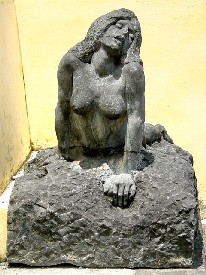 atomic bomb. The French would not take heed to these weapons of mass destruction even in 1902. An estimated (?) 29,933 people burned to death, leaving only two survivors in the town, a cobbler who was in his cellar, and the infamous Cyparis, imprisoned for murder in a stone cell. After recovering from his burns Cyparis joined P T Barmun. Before the eruption St. Pierre was known as the Paris of the Caribbean and was the commercial, cultural and social center of Martinique. Today it relies almost extensively on tourism and fishing. atomic bomb. The French would not take heed to these weapons of mass destruction even in 1902. An estimated (?) 29,933 people burned to death, leaving only two survivors in the town, a cobbler who was in his cellar, and the infamous Cyparis, imprisoned for murder in a stone cell. After recovering from his burns Cyparis joined P T Barmun. Before the eruption St. Pierre was known as the Paris of the Caribbean and was the commercial, cultural and social center of Martinique. Today it relies almost extensively on tourism and fishing.
Sailing the leeward side of these islands can prove to be quite challenging. You first approach the tip of the island finds high winds as they curve around the northern end then the wind dies. Its much like a checker board game trying to find enough wind that is blowing from the right direction. The mountains and valleys channel the wind and block it and do many things we are not yet good at interpreting. At one point we were on a starboard tack and the boat on the same heading not a quarter of a mile away was on a port tack. Heading furthered off-shore is one answer but of course that means more motoring or a longer tack back to your destination.
So for now we continue south in the lee of these tropical islands and expect to one day run into South America but with sailing you never know.
24 April 2003
St Anne. Martinique, French Antilles N 14.2646 W60.5303
Ahh the French
We have had many inquiries and comments about my recently attempt to cultivate a mustache and surprisingly many have not been positive. In fact of the slightly less than one hundred unsolicited comments over 95 have been negative (all from Rene's mother) and only two positive, thanks to Cousin Fred and Rene's sister Donna.
So that you might see how it looks we have included the picture below. 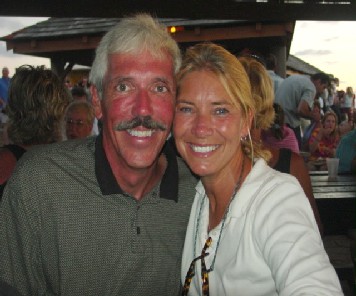 Now you must remember that I only grow a mustache every 32 years or so. The only drawback is that it allows water to leak into my mask while snorkeling but that's not much a penalty for this small stab at nonconformity as if cursing isn't. Sadly this mustache doesn't look much better today than my first attempt, but what the hey. As my friend Dick Brownlee says, "Hey you da pirate you don't need to apologize for nuttin". I don't know if the mustache gives me a more nautical look or not but that's where it ends since I can assure you that there has been no body art nor body piercing during this leg of our adventure. Now you must remember that I only grow a mustache every 32 years or so. The only drawback is that it allows water to leak into my mask while snorkeling but that's not much a penalty for this small stab at nonconformity as if cursing isn't. Sadly this mustache doesn't look much better today than my first attempt, but what the hey. As my friend Dick Brownlee says, "Hey you da pirate you don't need to apologize for nuttin". I don't know if the mustache gives me a more nautical look or not but that's where it ends since I can assure you that there has been no body art nor body piercing during this leg of our adventure.
Including this picture also answers a request we had from good friends, John and Trink Hollett, to include more pictures of ourselves. They have just returned from a ten day trip to Ireland a place they vacation often and having just finished McCarthy's Bar by Pete McCarthy I can understand why. I highly recommend the book if you can't make the trip.
Okay so back to sailing. We have arrived at St. Anne's on the southern tip of Martinique. With so much time in the French Antilles we have had an opportunity to practice our French and it is improving. Now when we visit gift shops I like to hold up an object turn it over and loudly state "Marchandise de Iraqi" at which point we abruptly leave the store. I think they get the point.
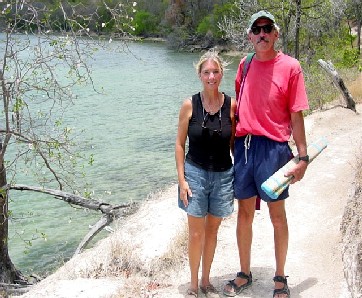
In the Caribbean we have only read or heard comments about how the war is ruining the Caribbean economy. Nothing about weapons of mass destruction, civil liberties, human rights, terrorism or from a different point superpowers bullying smaller nations, preemptive actions or the US interest in oil, only how fewer tourist there are. On some islands in the eastern Caribbean seventy percent of the tourists are from the US and islanders believe that travel is down because of the war not the economy. It makes the point that it's the economy and self interest that makes for good politics in less prosperous countries. We must say that the French Antilles are some of the cleanest islands we have visited with a better infrastructure than most other islands. Martinique imports goods valued at $1.7 billion Euros and exports only $200 million E's. It's obvious they need the tourism industry. So far everyone has been very helpful with the exception of the mayor of St Anne's whom we have not yet met. But rumor has it that the mayor dislikes all the US boats that crowd the St Anne's harbour.
St Anne's is such an attractive location that Club Med is on the peninsula not a quarter of a mile from where we dropped our hook. The cruisers anchored here are a well organized bunch having a local radio net that announces bocce ball tournaments, Friday evening cocktail parties, water aerobics and lots of other chatter. As we get closer to Trinidad we find people who have settled in for a life in these local waters and do not take their boat any further north than Martinique. Their motto is "This boat won't go where coconuts don't grow".
We also seem to have passed some demarcation line for mega yachts. We haven't seen any below latitude 15 and assume they are headed north for the summer season in the US and work off the east coast. The cruisers seem to think that most mega yachts are no more than channels for illegal money laundering activities. I'm not certain how that would work since they are seldom out on a charter and sit dockside at considerable expense. The idea seems to be that someone with a lot of money to hide would charter the boat, pay for the charter and then cancel out losing a large prepaid amount. Somehow the income generated by the boat, which is incorporated in a tax haven such as the Cayman Islands, would then be from a legitimate enterprise and the drug dealer or corporate accountant would also have a nice vacation spot . It's probably more a case of envy on the part of cruisers but it does spin an interesting tale.
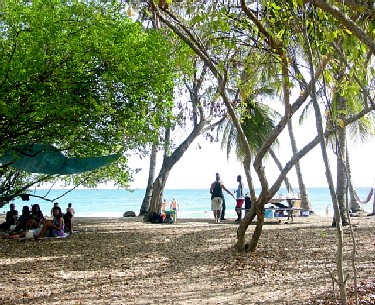
The shore on the southern coast of Martinique is a long national park with some of the most beautiful beaches that stretch for mile after mile. On the weekends they are crowded with locals and tourists and a couple of yachties. After a two hour trek of the shore line we were famished and finding a temporary beachside snack bar ordered "American sandwiches". The sandwich was comprised of a broken up hamburger, freedom fries and relish all stuffed in a french baguette. It was delicious and I highly recommend that McDonalds look into this as a new selection on the menu. Kind of a International Happy Meal with a Coke Light of course.
Now for an early morning departure for St. Lucia.
Back Next
|